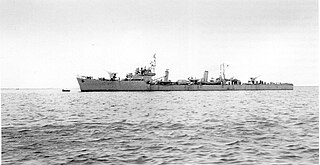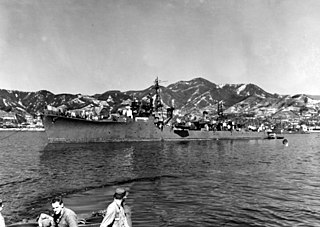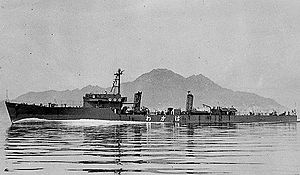
Momi was a Matsu-class destroyer of the Imperial Japanese Navy (IJN), sunk on 5 January 1945 by an American air attack west of Manila, in the South China Sea.

Sakura was one of 18 Matsu-class destroyers built for the Imperial Japanese Navy (IJN) during the final stages of World War II. Completed in late 1944, the ship was assigned to convoy escort duties in February 1945. She was slightly damaged when she struck a mine in May. Sakura sank after striking another mine near Osaka on 11 July with heavy loss of life.

Kaya was one of 18 Matsu-class escort destroyers built for the Imperial Japanese Navy (IJN) during World War II. Completed in late 1944, the ship began convoy escort duties in October. She was slightly damaged by American aircraft while escorting cruisers on a bombardment mission in the Philippines during Operation Rei in December. Kaya spent the rest of the war escorting convoys and capital ships after repairs.

Kaede was one of 18 Matsu-class destroyers built for the Imperial Japanese Navy (IJN) during the final stages of World War II. Completed in late 1944, the ship was assigned to convoy escort duties in January 1945. After escorting one convoy to southern China, she joined two other destroyers tasked to evacuate Japanese airmen from the Philippines. En route the ships were attacked by American bombers that badly damaged Kaede. The ship returned to Japan for repairs and was inactive for the rest of the war. She was surrendered to the Allies at the end of the war and used to repatriate Japanese troops until 1947. Mid-year the destroyer was turned over to the Republic of China; renamed Heng Yang she became a training ship and remained in service until the 1960s when she was scrapped.

Tachibana (橘) was the lead ship of her sub-class of the Matsu-class escort destroyers built for the Imperial Japanese Navy during the final stages of World War II. Completed in early 1945, the ship was assigned to convoy escort duties in home waters. She was sunk on 14 July with the loss of 135 crewmen by American carrier aircraft attacking targets in southern Hokkaido.

Nire was one of 23 escort destroyers of the Tachibana sub-class of the Matsu class built for the Imperial Japanese Navy during the final stages of World War II. Completed in early 1945, the ship spent most of her brief career assigned to the Combined Fleet on escort duty. Nire was damaged during a bomber attack on Kure in June; although she was repaired, the ship was placed in reserve the following month. The non-operational destroyer was turned over to the victorious Allies when the Empire of Japan surrendered in August; Nire was scrapped in 1948.

Kaki was one of 23 escort destroyers of the Tachibana sub-class of the Matsu class built for the Imperial Japanese Navy during the final stages of World War II. Completed in March 1945 the ship was lightly damaged during an American airstrike later that month. She was used to repatriate Japanese personnel after the war until 1947. Mid-year the destroyer was turned over to the United States and subsequently scrapped.

Kaba was one of 23 escort destroyers of the Tachibana sub-class of the Matsu class built for the Imperial Japanese Navy during the final stages of World War II. Completed in mid-1945, the ship was slightly damaged during the American attacks on Kure and the Inland Sea in July. She was used to repatriate Japanese personnel after the war until 1947. Mid-year the destroyer was turned over to the United States and subsequently scrapped.

Tsuta was one of 23 escort destroyers of the Tachibana sub-class of the Matsu class built for the Imperial Japanese Navy during the final stages of World War II. Completed in February 1945, she finished training in late April, but does not appear to have seen any subsequent use during the war. The ship was surrendered to the Allies at the end of the war and used to repatriate Japanese troops until 1947. Mid-year the destroyer was turned over to the Republic of China and was renamed Hua Yang. The ship ran aground in 1949 and was wrecked; she was not stricken until 1954.

Hagi was one of 23 escort destroyers of the Tachibana sub-class of the Matsu class built for the Imperial Japanese Navy during the final stages of World War II. Completed in March 1945, the ship was slightly damaged in July by American aircraft. She was used to repatriate Japanese personnel after the war until 1947. Mid-year the destroyer was turned over to Great Britain and subsequently scrapped.

Sumire was one of 23 escort destroyers of the Tachibana sub-class of the Matsu class built for the Imperial Japanese Navy during the final stages of World War II. Completed in March 1945, she saw no combat during the war and was used to repatriate Japanese personnel after the war until 1947. Mid-year the destroyer was turned over to Great Britain and subsequently sunk as a target.

Kusunoki was one of 23 escort destroyers of the Tachibana sub-class of the Matsu class built for the Imperial Japanese Navy during the final stages of World War II. She was used to repatriate Japanese personnel after the war until 1947. Mid-year the destroyer was turned over to Great Britain and subsequently scrapped.

Enoki was one of 23 escort destroyers of the Tachibana sub-class of the Matsu class built for the Imperial Japanese Navy during the final stages of World War II. The ship was completed in early 1945 and was sunk by a naval mine in June. Her wreck was salvaged in 1948 and subsequently scrapped.

Odake was one of 23 escort destroyers of the Tachibana sub-class of the Matsu class built for the Imperial Japanese Navy during the final stages of World War II. She was used to repatriate Japanese personnel after the war until 1947. Mid-year the destroyer was turned over to the United States and subsequently scrapped.

Shii was one of 23 escort destroyers of the Tachibana sub-class of the Matsu class built for the Imperial Japanese Navy during the final stages of World War II. Completed in March 1945, she struck a mine in June, but was only lightly damaged. The ship was used to repatriate Japanese personnel after the war until 1947. Mid-year the destroyer was turned over to the Soviet Union, renamed Volny and was commissioned that same year. She was renamed TsL-24 and converted into a target ship two years later; the ship was ordered to be scrapped in 1960.

Hatsuume was one of 23 escort destroyers of the Tachibana sub-class of the Matsu class built for the Imperial Japanese Navy during the final stages of World War II. Damaged by a naval mine shortly after her completion in June 1945, the ship was surrendered to the Allies at the end of the war and used to repatriate Japanese troops until 1947. Mid-year the destroyer was turned over to the Republic of China; renamed Xin Yang she played a minor role in the Chinese Civil War and remained in service until the 1960s when she was scrapped.

Keyagi was one of 18 Matsu-class escort destroyers built for the Imperial Japanese Navy (IJN) during World War II. Completed in late 1944, little is known about her activities during the rest of the war. The ship was surrendered to the Allies at the end of the war and used to repatriate Japanese troops until 1947. Mid-year the destroyer was turned over to the United States and was later sunk as a target.

Maki was one of 18 Matsu-class escort destroyers built for the Imperial Japanese Navy during World War II. Completed in mid-1944, the ship was damaged during the Battle off Cape Engaño in October by American aircraft. After repairs she was assigned to escort duties and was torpedoed by an American submarine in early 1945. Maki resumed her duties once her damage was repaired and remained in home waters for the rest of the war.

Nara was one of 18 Matsu-class escort destroyers built for the Imperial Japanese Navy (IJN) during World War II. Completed in November 1944, the ship was badly damaged when she struck a naval mine in June 1945. She was not repaired before the end of the war and was scrapped in 1948.

Tsubaki was one of 18 Matsu-class escort destroyers built for the Imperial Japanese Navy (IJN) during World War II. Completed in late 1944, the ship began convoy escort duties in the Shanghai, China, area early the following year. After being damaged by a naval mine in April 1945, she returned home for repairs the following month. Tsubaki was damaged when American aircraft attacked targets in Japan in July and was not repaired before the end of the war several months later. The ship was scrapped in 1948.








